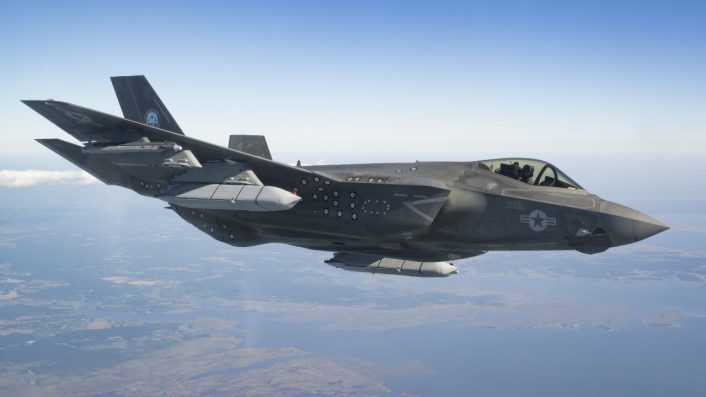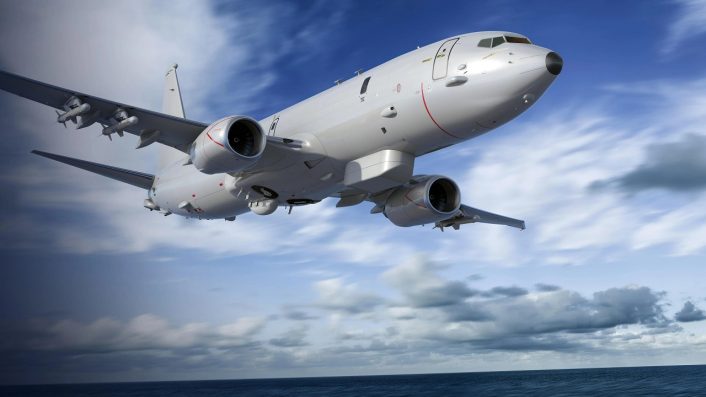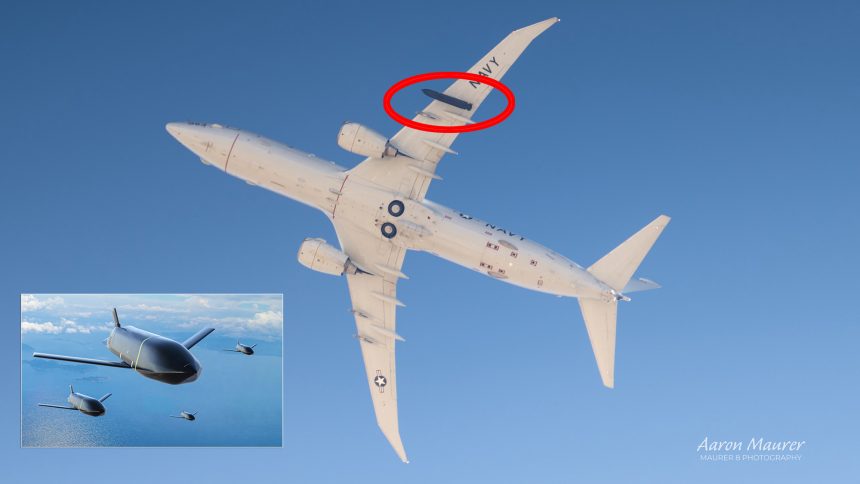A Poseidon was spotted flying over the Mojave Desert with the long range anti-ship missile last month.
A U.S. Navy P-8 Poseidon aircraft was recently spotted carrying a LRASM (Long Range Anti-Ship Missile) in flight for the first time. On Aug. 28, 2025, aviation photographer Aaron Maurer shared on X a photo of the jet flying over the Mojave Desert with the missile clearly visible under its left wing.
A KC-46 Pegasus and P-8 Poseidon flying over Mojave. Interested combo. #kc46 #p8 pic.twitter.com/aG0VzKvhDo
— maurer8photography (@maurer8photo) August 28, 2025
The Navy later confirmed to Newsweek that the missile was an LRASM and said integration work on the P-8A is in progress.
The integration of the LRASM has been known for some years, but what makes Maurer’s shot particularly interesting is that it is the first photo showing the weapon carried on an underwing pylon in flight, likely during a test mission. Therefore, we reached out to Maurer for additional details about the rare sighting.
“It was taken the middle of August over Mojave,” told us Maurer. “I didn’t mention the LRASM initially because I was trying to keep it low key, people still took notice.”
“Spending a lot of time around the Mojave area I’m always watching the skies. I wasn’t listening to a scanner, just listening for the faint rumble of something in the air. The KC-46 Pegasus passed overhead first. A few seconds later the P-8 Poseidon followed the same line. They both continued north eventually going out of sight. I’m not sure where they originated from, but it was cool seeing them. Nothing should be surprising in the Mojave desert, but a P-8 with an LRASM under the wing was unexpected. It always pays off to watch the skies and listen.”
The AGM-158C
The AGM-158C LRASM (Long Range Anti-Ship Missile) is derived from the AGM-158B Joint Air-to-Surface Standoff Missile – Extended Range (JASSM-ER) and represents the new stealthy cruise missile designed by DARPA for the U.S. Air Force and U.S. Navy. According to NAVAIR, LRASM provides a near-term solution to the Offensive Anti-Surface Warfare (OASuW) requirement, filling the air-launched capability gap with a flexible, long-range weapon able to engage high-value maritime targets in heavily defended environments.
The missile has been engineered to operate with reduced reliance on Intelligence, Surveillance and Reconnaissance (ISR) assets, data links, and GPS, even in jamming-heavy scenarios. After launch, LRASM navigates to an initial point using GPS guidance, then relies on its onboard sensors to autonomously detect, classify, and engage the designated ship. Advanced algorithms allow it to refine less precise targeting data and prosecute specific vessels in contested waters.
Three variants make up the OASuW Increment 1 program: LRASM 1.0, LRASM 1.1, and LRASM C-3. The baseline LRASM 1.0 achieved early operational capability in 2019 and has already been integrated on the B-1B Lancer and the F/A-18E/F Super Hornet.
The follow-on LRASM 1.1, fielded in 2023, is currently undergoing Initial Operational Test & Evaluation, as reported by the Director, Operational Test and Evaluation. Integration on the P-8A Poseidon is also underway, with completion initially expected by the summer of 2024 and later postponed to 2025. For surface strike missions, the P-8A Poseidon can already carry four AGM-84 Harpoons under its four underwing hardpoints, but the new missile brings additional, advanced long-range sea and land strike capabilities to the Poseidon.

Increment 3 Block 2 Modifications
The new missile is being integrated as the U.S. Navy has delivered the Increment 3 Block 2 upgrade to the first of 141 P-8A.
Increment 3 Block 2 represents a major step forward for the Poseidon, bringing both airframe and avionics enhancements. The package introduces new structural racks, radomes, antennas, sensors, and wiring, along with a completely updated combat systems suite. This includes improved computer processing power, a more secure architecture, a wideband satellite communications system, an ASW signals intelligence capability, a track management system, and expanded communications and acoustic systems to improve search, detection, and targeting.
“Increment 3 Block 2 brings the capability that the P-8A was made for. These modifications will allow aircrews to search, locate and track the most advanced submarines in the world, enabling the fleet to pace the threat with the required capability and capacity to win the fight,” said Capt. Erik Thomas, program manager for the Maritime Patrol and Reconnaissance Aircraft office (PMA-290). “This delivery demonstrates the PMA-290 team’s outstanding work ethic, professionalism and dedication to the fleet.”
According to the service, these modifications will equip the fleet with the full spectrum of anti-submarine warfare (ASW), anti-surface warfare (ASuW), and intelligence, surveillance and reconnaissance (ISR) capabilities envisioned in the P-8A program’s evolutionary acquisition strategy.
The modification work is being carried out by Boeing at its Maintenance, Repair and Overhaul facility at Cecil Airport in Jacksonville, Florida, and the first P-8A Poseidon “Increment 3 Block 2” (I3B2) flew for the first time after the upgrades in June 2025.

Making the P-8 more capable
The ongoing integration of the LRASM on U.S. military aircraft comes as China seeks to project an image of growing military power, highlighted by the massive parade it held this week. At the same time, tensions are also rising in the Western Hemisphere, where the U.S. military carried out a lethal strike against a suspected Venezuelan drug vessel in what was the first known use of direct military force against a drug cartel’s maritime operations since the deployment of additional U.S. warships to the Caribbean region, further stressing the need for capable maritime patrol and strike platforms.
As noted by Newsweek’s Ryan Chan in his report on the LRASM integration, China now operates the world’s largest navy by hull count, with more than 370 ships and submarines in service. This force underpins Beijing’s effort to expand its presence across the Western Pacific and directly challenge U.S. naval power in the region. In response, the United States has deployed land-based anti-ship missile systems in the Pacific and continues to bolster allied capabilities with U.S.-made ship-sinking weapons.
In this context, the P-8A Poseidon, designed for anti-submarine and anti-surface warfare as well as for ISR (intelligence, surveillance and reconnaissance) missions, remains a key asset. The U.S. Navy routinely employs the aircraft for patrols and joint exercises over strategic hotspots such as the Taiwan Strait and the South China Sea, where tensions with China remain high, but also uses the Poseidon in the Western Atlantic and Caribbean, where it monitors narco-trafficking routes and Venezuelan naval activity.
The addition of the LRASM, along with Increment 3 Block 2 upgrades and the Multi-Mission Pod (MMP), will significantly expand the Poseidon’s ability to counter surface threats across both theaters. This ensures the aircraft can not only monitor and track but also strike hostile vessels at long range, reinforcing U.S. and allied deterrence against both China’s growing naval power in the Indo-Pacific and emerging threats in the Western Hemisphere.
A big thank you to Aaron Maurer for allowing us to use his photograph. Make sure to follow him on X and Instagram!









